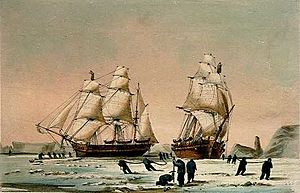HMS Enterprise (1848) facts for kids

HMS Enterprise (left) and HMS Investigator (right)
|
|
Quick facts for kids History |
|
|---|---|
| Name | Enterprise |
| Builder | Money Wigram and Sons, Blackwall |
| Cost | £24,545 |
| Launched | 5 April 1848 |
| Acquired | Purchased February 1848 on stocks |
| Fate |
|
| General characteristics | |
| Class and type | Arctic Discovery Ship |
| Tonnage | 471 tons (Builder's Measure) |
| Length | 125.6 ft (38.3 m) |
| Beam | 28.8 ft (8.8 m) |
| Depth of hold | 20 ft (6.1 m) |
| Sail plan | Barque-rigged |
HMS Enterprise was a special ship built to explore the Arctic. It was originally going to be a merchant ship, but the British Navy bought it in 1848. They wanted it to help search for Sir John Franklin's lost expedition. The ship went on two big trips to the Arctic. Later, it was used to store coal before being sold in 1903. It was the tenth ship named Enterprise in the Royal Navy.
Building the Enterprise
The Enterprise started as a regular merchant ship. It was being built at the Blackwall shipyard in London. This yard was located on the River Thames. The company building it was Money Wigram and Sons.
In February 1848, the Admiralty (the British Navy's leaders) bought the ship. They bought it even before it was finished. They then prepared it for journeys to the cold Arctic. The ship was officially launched on April 5, 1848.
Adventures and Later Use
The Enterprise made two important voyages to the Arctic. Its first trip was in 1848-1849. This journey went through the Atlantic Ocean. It was led by a famous explorer named James Clark Ross.
The second voyage was from 1850 to 1854. This time, the ship traveled through the Pacific Ocean. It went through the Bering Strait, a narrow sea passage. This expedition was led by Richard Collinson.
After its exploring days, the Enterprise had a new job. From 1860, it was used as a coal hulk. This means it was a ship that stayed in one place to store coal. It was located at Oban, a town in Scotland. The ship was lent to the Commissioners of Northern Lights for this purpose.
Later, in 1889, it was lent to the Board of Trade. Finally, the Enterprise was sold in 1903.

